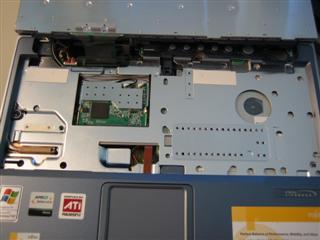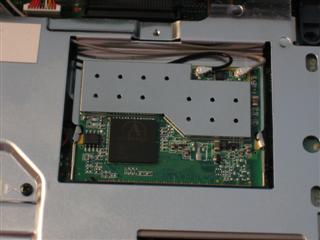Install finish and Closing Thoughts
Step 5: All you need to do now is slip the mini-PCI card into the slot and attach the antennas. Yes, those really are teeny-tiny connectors, which require patience and care when connecting. Make sure that the cable and board connectors are aligned and parallel before you push them together.

Figure 9: Card installed
I was a little paranoid and put insulating tape on the area where the WLAN board could possibly touch. I also supported the board while pushing the connectors together because the board wasn't otherwise supported from below and I didn't want to stress the connector.

Figure 10: Close-up of installed card
By the way, don't worry about which color antenna cable connects to which connector on the card. With the diversity antenna system used by all wireless LAN cards, it doesn't matter!
With the card install completed, I carefully lowered the keyboard into position, but didn't button everything up yet. Instead, I reinstalled the battery, booted up and was pleased to see the Windows hardware install wizard detect the WLAN card. All I had to do was answer the wizard's prompts and was rewarded with a successful install.
TIP: Be sure to read whatever README or documentation that comes with your downloaded driver, since some adapters want you to run a program before installing hardware that puts the drivers in their proper place and usually installs a client program.
With the card up and running, all I had to do was open the client application (or use Win XP's Wireless Zero Configuration utility), scan for my LAN's access point and associate with it. Fortunately, all this went without a hitch. Once I knew the card was running, I shut down and put everything back together. Mission accomplished!
While things went pretty smoothly for me, your experience may not go as well. I've seen reports of some manufacturers allowing only specific WLAN cards that they have tested to be used in their notebooks, while others may not make drivers readily available. And then there's always the challenge of figuring out how to get at the WLAN card mini-PCI slot, which manufacturers tend to not make as accessible as memory and hard-drives.
But if you didn't like a challenge, then you wouldn't be thinking of doing this anyway!
Revised January 28 2005
A helpful reader submitted these links to an HP support article and support forum thread that provide information on some HP notebooks (nc6000) that are picky about the WLAN cards that they allow to be installed. He also reported that the nc8000 has the same problem.
Revised February 22 2005
Engadget pointed the way to a couple of articles that have more details on notebooks that are fussy about which mini-PCI WLAN cards they accept. This article has info on X40 and R31 IBM ThinkPads and contains info describing how to hack the BIOS to get other cards to work. This article is a shorter summary of what needs to be done, but has no details. Note that these procedures assume you are comfortable with hex editors and could leave you with a dead notebook!
Another helpful reader offered this tip for Toshiba notebook owners:
I recently tackled adding a wireless mini-pci card to my notebook. I found an Intel 2200BG mini-PCI card on eBay and installed it in my Toshiba Satellite 1905. It turns out that pins 11-16 of the mini-PCI spec are user-defined (hardware on off, activity, etc.) Although card and slot were mini-PCI, Toshiba uses the pins differently and I could not get the radio turned on. Covering pins 11 and 13 with tape solved this.